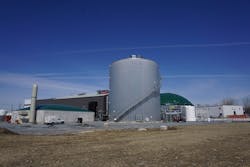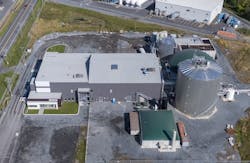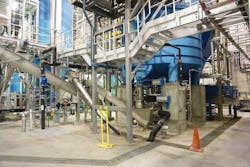About the author:
Sara Myers is associate editor for WWD. Myers can be reached at [email protected]
or 847.391.1007.
- Location: Varennes, QC
- Size: 40,000 tons per year
- Infrastructure: Pretreatment with hydro pulper and two grit removal systems; two digesters; agitation; two dewatering systems; ammonia-stripping unit; membrane bioreactor; and biogas treatment with flare and biogas dryer.
In 2012, a public-private partnership was formed between Biogaz EG and three regional county municipalities (MRCs) of La Vallée-du-Richelieu, Marguerite-D’Youville and Rouville, a group of 27 area municipalities. According to CCI BioEnergy, the partnership was formed to deliver an organics-recovering solution for the community in Varennes, QC, using anaerobic digestion (AD).
BTA Intl. GmbH (BTA), a specialist in the wet-mechanical pretreatment and subsequent digestion of organic waste containing impurities, and CCI BioEnergy Inc. completed the major waste-to-gas facility in Varennes. Operation began in March 2018.
Société d’Économie mixte de l’est de la Couronne Sud Inc. (SÉMECS) owns the facility, which was commissioned on July 30, 2018.
“SÉMECS is a private company in Quebec,” said Sylvain Trepanier, director of Biogaz EG. “We have 27 municipalities and we provide services for 250,000 people.”
Trespanier is president of Biogaz EG’s board and also is on the board for SÉMECS.
SÉMECS selected BTA and CCI BioEnergy Inc. to design and supply the BTA Process for the project. BTA and CCI delivered a services package that provided the facility and process design, key process equipment, the software components for the plant, and a training and start-up package through to the daily operations phase.
BTA benefits from the legal requirements to recycle organic waste rather than landfilling it. The company has more than 30 years of experience in processing and digestion technology, and has built 50 plants worldwide using the BTA process.
According to Trespanier, SÉMECS has the responsibility to receive and treat 40,000 tons of organic waste per year. At that amount, it produces digestate that is then transferred to the farm field, which creates biogas. The biogas then is sent to Greenfield Global Québec Inc., an ethanol facility, with whom it has a partnership.
The plant treats household organic waste the residents generate. It also receives and processes commercial organic material from various sources and converts it into biogas. The biogas is used to fuel the boilers, which provide the required heat for the facility and the biological processes. Greenfield uses the majority of the biogas, replacing a portion of the natural gas the company uses in its process.
Challenges
The first challenge for Biogaz EG did not concern the plant itself—it was the relationship between the private and public companies. According to Trepanier, the companies had different goals. For the private company, it was to make money, and for the public company, it was to provide a service to the population.
Their second challenge was finding the right technology provider, because the experience it has in Quebec with the AD plant was limited.
“Historically in the province of Québec, we have three or four AD facilities, but only for the wastewater treatment plant,” Trepanier said. “In our case, we don’t treat the wastewater—only the organic waste.”
The company did not have any experience in that practice in North America and Canada specifically. Trepanier said it needed to find a way to get experience in that treatment. It has tried to work with BTA, which would provide the service and equipment for the plant.
The equipment providers’ timeline is another challenge.
“Sometimes the provider will say we need 16 months to provide the equipment, and then the equipment arrives one or two months later,” Trepanier said. “It is difficult for the clarification of the project.”
Digestion
More than 90% of the available and digestible organics is captured and converted, including disposable diapers and compound packaging.
“We accept diapers, green waste, branches of leaves,” Trepanier said. “However, sometimes we receive materials and we need to first remove the contaminants inside.”
The resulting nutrient-rich digestate is applied on about 400 farms that grow the corn to supply the ethanol facility, according to BTA. The digestate is a soil conditioner, providing moisture retention and organic content, as well as improving soil aeration and structure.
Excess liquids are treated in an onsite wastewater treatment plant before being discharged. The nitrogen is stripped from the water and used as a high-value agricultural fertilizer, and then the extracted inert residual contaminants are compacted and shipped to landfill.
Equipment
The facility is designed and built on BTA’s technology platform, the BTA Process. The annual design capacity is 40,000 metric tons of residential source-separated organics, grass clippings, septage, and various industrial, commercial and institutional sources. The liquid organics are fed directly into the digesters.
The equipment includes a pretreatment system, a process water system, a biogas system and more. The pretreatment system includes one 32-cu-meter hydro pulper and two grit removal systems, all provided by BTA.
The digestion system includes two digesters with a total capacity of 8,800 cu meters. Agitation is provided by BTAI. There also are two dewatering systems provided by Fournier.
The process water system includes one ammonia-stripping unit provided by CMI Europe Environnement and one membrane bioreactor provided by Suez.
The Biogaz system has one flare and one biogas dryer. The facility has one biofilter provided by CMI Europe Environnement for odor control.
“For the pretreatment, we use a pulper or hydro pulper; we do this to create the suspension or pulp,” Trepanier said. “We have an hydrocyclone [a grit removal system] and a grit removal system. We receive organic waste with plastic bags.”
According to CCI BioEnergy, more than 95% of the available and digestible organics are captured and converted from disposable diapers and compound packaging. Any excess liquids are treated in an onsite wastewater treatment plant before being discharged to the St. Lawrence River. The stripped nitrogen then is used as a high-value agricultural fertilizer, and the extracted inert residual contaminants are compacted and shipped daily to landfill.
The plant is looking to expand in the future but will need to take some time to better optimize first.


